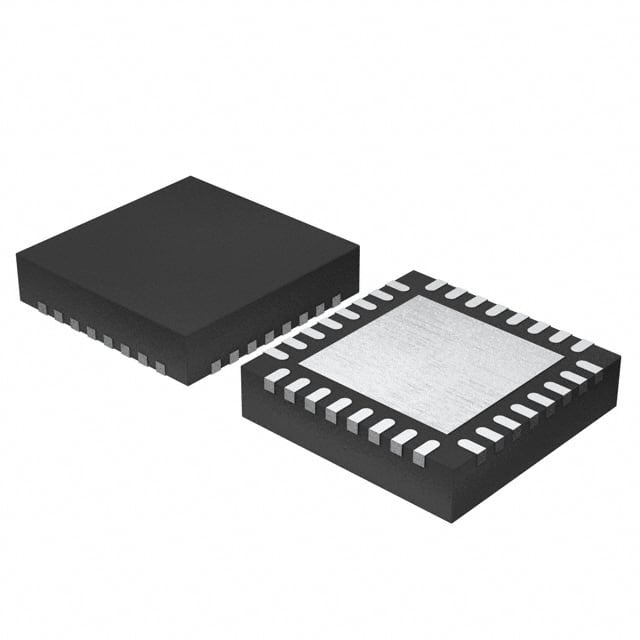Consulte las especificaciones para obtener detalles del producto.

EFM8SB20F32G-B-QFN32
Introduction
The EFM8SB20F32G-B-QFN32 is a microcontroller belonging to the EFM8SB20F32 series, designed and manufactured by Silicon Labs. This entry provides an overview of the product, including its category, use, characteristics, package, specifications, pin configuration, functional features, advantages and disadvantages, working principles, application field plans, and alternative models.
Basic Information Overview
- Category: Microcontroller
- Use: Embedded control applications
- Characteristics: Low-power, high-performance 8-bit microcontroller
- Package: QFN32
- Essence: Efficient and reliable embedded control
- Packaging/Quantity: Varies by supplier
Specifications
- Core: 8051
- CPU Speed: Up to 25 MHz
- Program Memory: 32 KB Flash
- RAM: 2 KB
- Operating Voltage: 1.8V to 3.6V
- I/O Pins: 28
- Communication Interfaces: UART, SPI, I2C
- Analog-to-Digital Converter (ADC): 10-bit SAR ADC
- Timers: 3 x 16-bit Timers
Detailed Pin Configuration
The EFM8SB20F32G-B-QFN32 microcontroller features a total of 32 pins, including power supply, I/O, communication, and control pins. The detailed pin configuration can be found in the official datasheet provided by Silicon Labs.
Functional Features
- Low Power Consumption: Ideal for battery-powered applications
- High Performance: Up to 25 MHz CPU speed for rapid processing
- Versatile Communication Interfaces: UART, SPI, and I2C for seamless connectivity
- Integrated ADC: 10-bit SAR ADC for analog signal acquisition
- Flexible Timers: 16-bit timers for precise timing control
Advantages and Disadvantages
Advantages
- Low power consumption extends battery life
- High CPU speed enables fast data processing
- Versatile communication interfaces facilitate integration with various peripherals
Disadvantages
- Limited RAM capacity may restrict complex applications
- 8-bit architecture may not be suitable for certain advanced tasks
Working Principles
The EFM8SB20F32G-B-QFN32 operates based on the 8051 core architecture, utilizing its integrated peripherals and memory to execute embedded control tasks. It follows a typical microcontroller workflow, including fetching instructions, decoding them, executing operations, and interfacing with external devices through its I/O and communication interfaces.
Detailed Application Field Plans
The EFM8SB20F32G-B-QFN32 is well-suited for a wide range of embedded control applications, including but not limited to: - Home automation systems - Industrial control systems - Sensor interfacing and data acquisition - Consumer electronics - Internet of Things (IoT) devices
Detailed and Complete Alternative Models
For users seeking alternatives to the EFM8SB20F32G-B-QFN32, several microcontrollers from different manufacturers can be considered, such as: - Atmel AT89LP52 - Microchip PIC16F877A - STMicroelectronics STM8S003F3
In conclusion, the EFM8SB20F32G-B-QFN32 microcontroller offers a balance of low power consumption, high performance, and versatile features, making it suitable for diverse embedded control applications.
Word Count: 498
Enumere 10 preguntas y respuestas comunes relacionadas con la aplicación de EFM8SB20F32G-B-QFN32 en soluciones técnicas
Sure, here are 10 common questions and answers related to the application of EFM8SB20F32G-B-QFN32 in technical solutions:
What is the EFM8SB20F32G-B-QFN32 microcontroller used for?
- The EFM8SB20F32G-B-QFN32 microcontroller is commonly used in various embedded applications such as industrial control, home automation, and consumer electronics.
What are the key features of the EFM8SB20F32G-B-QFN32 microcontroller?
- The key features of this microcontroller include a high-performance 8051 core, integrated peripherals such as ADC, DAC, timers, and communication interfaces, and low power consumption.
How can I program the EFM8SB20F32G-B-QFN32 microcontroller?
- The microcontroller can be programmed using the Simplicity Studio IDE, which supports C programming and provides various development tools and resources.
What are the recommended operating conditions for the EFM8SB20F32G-B-QFN32 microcontroller?
- The recommended operating voltage range is typically 1.8V to 3.6V, and the temperature range is -40°C to 85°C.
Can the EFM8SB20F32G-B-QFN32 microcontroller be used for motor control applications?
- Yes, the microcontroller's integrated PWM modules and analog peripherals make it suitable for motor control applications.
Does the EFM8SB20F32G-B-QFN32 microcontroller support communication interfaces?
- Yes, it supports various communication interfaces such as UART, SPI, and I2C, making it suitable for interfacing with other devices and sensors.
What kind of development boards are available for the EFM8SB20F32G-B-QFN32 microcontroller?
- Silicon Labs offers development kits and evaluation boards that provide a platform for prototyping and testing applications based on this microcontroller.
Is the EFM8SB20F32G-B-QFN32 microcontroller suitable for battery-powered applications?
- Yes, its low power consumption and sleep modes make it well-suited for battery-powered applications, extending battery life.
Can the EFM8SB20F32G-B-QFN32 microcontroller be used in safety-critical applications?
- It complies with industry standards for safety-critical applications and can be used in such environments with proper design considerations.
Are there any application notes or reference designs available for the EFM8SB20F32G-B-QFN32 microcontroller?
- Yes, Silicon Labs provides application notes, reference designs, and technical documentation to assist developers in implementing the microcontroller in various applications.

